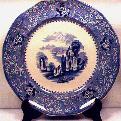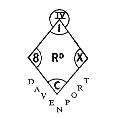Transfer ware
|
Transfer ware |
|
![]()
![]() If
you are asking: "Do I have any transfer ware? Have I ever seen
any?"
If
you are asking: "Do I have any transfer ware? Have I ever seen
any?"
.... particularly well known transfer patterns are "Blue Willow" or "Indian tree" This is transfer ware.

Example of Adams
transfer ware
(click for larger picture)
![]() Transfer printing was developed in response to a call by English consumers for
less expensive, mass produced wares. Customers wanted embellishment on their
previously plain utilitarian wares. Initially the patterns were oriental in
flavor, as Chinese blue was a favorite of the time.
Transfer printing was developed in response to a call by English consumers for
less expensive, mass produced wares. Customers wanted embellishment on their
previously plain utilitarian wares. Initially the patterns were oriental in
flavor, as Chinese blue was a favorite of the time.
Prior to the development of transfer printing only the most affluent English
could afford complete dinnerware sets as every dish had been carefully hand
painted by an artisan. This was a labour intensive and costly process. Transfer
printing allowed hundreds of sets of dinnerware to be produced in a fraction of
the time it would have taken to hand paint these items, and for a fraction of
the cost.
Colours
Transfer printing was originally produced in one colour items only. Some time later the technology was developed to allow double or triple color transfers. This meant that the rim of a plate may be one color and the center design may be another. Another method of embellishment was that a single color transfer item may be hand painted inside the confines of the design (like petals and leaves) and then glazed. This was called "clobbering". It is speculated that clobbering was developed in response to the cry by out of work artisans who had been replaced by transfer printing. Later a process called polychroming was used. This produced very bright almost enamelled looking colors with a high glaze.
![]() Single color transfers are found in blue
(many hues), red (called pink), black (called jet) brown (often called sienna),
purple (Mulberry being one of them) and green. More rare are yellow transfers.
Brown is a very common color and is the least expensive. Blue is the most sought
after color and tends to be the most expensive. Flow Blue was originally a
mistake. The cobalt pigment in the decorative glaze could not withstand the heat
of the second firing and ran. Thus Flow Blue pieces have that runny, blurry
quality about them. While initially this was a manufacturer's error, Flow Blue
is the most popular transfer color today. Transfer designs are sometimes
combined with other glaze treatments such as lustre. Often you will see ceramic
items that have a lustre glaze but also incorporate a transfer design.
Single color transfers are found in blue
(many hues), red (called pink), black (called jet) brown (often called sienna),
purple (Mulberry being one of them) and green. More rare are yellow transfers.
Brown is a very common color and is the least expensive. Blue is the most sought
after color and tends to be the most expensive. Flow Blue was originally a
mistake. The cobalt pigment in the decorative glaze could not withstand the heat
of the second firing and ran. Thus Flow Blue pieces have that runny, blurry
quality about them. While initially this was a manufacturer's error, Flow Blue
is the most popular transfer color today. Transfer designs are sometimes
combined with other glaze treatments such as lustre. Often you will see ceramic
items that have a lustre glaze but also incorporate a transfer design.
Designs
Transfer designs are varied and wide, oriental patterns were quite popular. These often incorporated scenes of Asian people and sometimes pagodas. The Romantic scenes are probably the most identifiable. These frequently carry images of a woman in a long dress with a parasol, and perhaps a suitor by her side. Often there are gardens and gazebos involved. Commemorative wares depict scenes of historical significance, like royal coronations or the launching of ships. Pastoral items tend to include scenes of rural life; farms, cattle, etc. Then there are the floral items and the novelty or juvenile items. Juvenile items were often developed in miniatures or children's sets and may depict children at play, trains, animals, and the like.
Dateing
![]() Dating and identifying items can be easy if the items are Registered under the
English system (see registered marks). The
registration process was similar to the Copyright system used today in the USA.
From 1842-1883 english items carried a diamond shaped mark which could be read
to decipher the actual day a pattern was registered. After 1884 the registry
went to a single number series, e.g., "Rd. No. 12342", which can be
used to determine the pattern registration date to within approximately one
year. Registration numbers greater than 360,000 indicate 20th century
manufacture.
Dating and identifying items can be easy if the items are Registered under the
English system (see registered marks). The
registration process was similar to the Copyright system used today in the USA.
From 1842-1883 english items carried a diamond shaped mark which could be read
to decipher the actual day a pattern was registered. After 1884 the registry
went to a single number series, e.g., "Rd. No. 12342", which can be
used to determine the pattern registration date to within approximately one
year. Registration numbers greater than 360,000 indicate 20th century
manufacture.

Registration Mark
![]() Other marks can be printed, incised or impressed, stamped, or hand-painted. Some
general rules of using marks for dating pieces include the following. The word
"Limited" or an abbreviation like "Ld." or "Ltd."
in the pottery firm's name indicates a date after 1860 and was not generally
used until the 1880's.
Other marks can be printed, incised or impressed, stamped, or hand-painted. Some
general rules of using marks for dating pieces include the following. The word
"Limited" or an abbreviation like "Ld." or "Ltd."
in the pottery firm's name indicates a date after 1860 and was not generally
used until the 1880's.
![]() Any piece having the word "Trade Mark" was manufactured after the
Trade Mark Act of 1862 and the words generally denote manufacture after 1875.
The word "England" may appear on an item after 1891 to comply with the
Mckinley Tariff Act. "Made In England" indicates 20th Century origins.
Unmarked items, as you might imagine, can be more difficult to trace in terms of
their origin. The type of body, glaze, styling and decoration technique will be
your most important clues to identification when there is no mark or the mark
was a commonly used device such as the anchor or royal arms.
Any piece having the word "Trade Mark" was manufactured after the
Trade Mark Act of 1862 and the words generally denote manufacture after 1875.
The word "England" may appear on an item after 1891 to comply with the
Mckinley Tariff Act. "Made In England" indicates 20th Century origins.
Unmarked items, as you might imagine, can be more difficult to trace in terms of
their origin. The type of body, glaze, styling and decoration technique will be
your most important clues to identification when there is no mark or the mark
was a commonly used device such as the anchor or royal arms.
Modern Ware
Transfer items are still produced today. In fact, some manufacturers like Spode have re-released some old patterns, particularly blue and white. If you are a beginning collector the best advice is to look at and handle every piece of transfer ware you see. Talk with dealers and other collectors, and read as many books on the subject as you can.
questions / comments? email Steve Birks steveb@netcentral.co.uk
Thanks to: Cynthia May - English
Transferware Mailing List for the basic text to this page
http://www.concentric.net/~Jspode/transfer.html